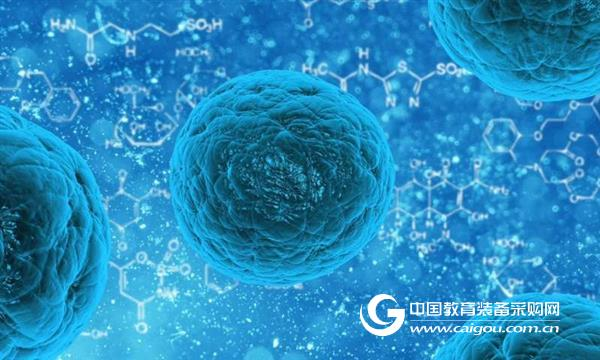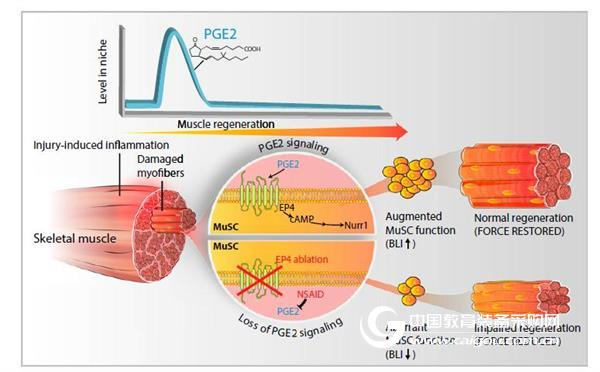A recent study from Stanford University School of Medicine revealed a protective effect of a common inflammatory factor, PGE2 (prostaglandin E2). After muscle damage or strenuous exercise, PGE2 activates muscle stem cells responsible for repairing damage and promotes muscle regeneration.

The inflammatory response is a double-edged sword that protects our body from pathogens and is the culprit of many diseases. In daily life, we mention that inflammation often refers to its unfavorable side. However, a recent study from the Stanford University School of Medicine revealed a protective effect of a common inflammatory factor, PGE2 (prostaglandin E2). After muscle damage or strenuous exercise, PGE2 activates muscle stem cells responsible for repairing damage and promotes muscle regeneration. Treatment of injured experimental mice with PGE2 can accelerate the ability of animals to repair damage and restore muscle strength. However, our commonly used non-steroidal anti-inflammatory drugs, such as aspirin or ibuprofen, block the action of PGE2, significantly inhibiting muscle repair in mice and leading to reduced strength. The study was published on PNAS on June 12.
PGE2 levels increase sharply after injury
Muscle stem cells are usually distributed around muscle fibers. When muscles are damaged by trauma or overuse, they are activated, rapidly divide, and produce enough muscle cells to repair the damage. PGE2 can enter muscle fibers when muscle tissue responds to damage. However, the specific role of inflammation in the process of activating muscle stem cells remains unclear. However, some studies have shown that anti-inflammatory treatment can adversely affect muscle recovery.
The researchers found that PGE2 may play an important role in muscle repair because its receptors are expressed at high levels on stem cells shortly after injury. They found that the gene encoding a PGE2 receptor, the level of EP4, was elevated in damaged muscle stem cells. In addition, the researchers found that the level of PGE2 in muscle tissue increased dramatically within three days after injury, which meant it was a transient, naturally occurring immune modulator.
To further determine its mechanism of action, the researchers constructed a genetically engineered experimental mouse that enabled them to dynamically monitor the number and activity of muscle stem cells over time. Also study how stem cells respond to injections of toxins or leg muscle damage caused by hypothermia.

PGE2 promotes muscle regeneration and strengthens muscle strength
"The transient pulse of PGE2 is a natural response to injury," said Helen Blau, senior author of the study. "When we exposed cultured muscle stem cells to PEG2 for one day, we found that PEG2 had a profound effect on cell proliferation. In comparison, the number of cells increased by a factor of six after one day of exposure to PEG2.
After observing this phenomenon in the cells, the researchers tested the effect of PGE2 injection on the leg muscles of mice.
Unsurprisingly, the researchers found that when they injected PGE2 into the muscles of mice, they not only significantly promoted muscle regeneration, but even increased muscle strength. Conversely, if muscle stem cells are inhibited from responding to PGE2, blocking EP4 expression, or non-steroidal anti-inflammatory drugs are administered to inhibit PGE2 production, power recovery is impeded.
Blau said: "Traditionally, inflammation is considered to be a natural but sometimes harmful physiological response. But we found that the inflammatory factor PGE2 has a profound effect on the proliferation of muscle cells in animals. Perhaps we can enhance the muscle cells in the stem cells. This process promotes muscle regeneration to help people with muscle damage, even against natural aging."
The researchers next plan to examine the effects of PGE2 on human muscle stem cells in the laboratory and examine the role of aging in this process. Because PGE2 is produced during pregnancy by the fetus and placenta and has been approved by the FDA for induction of labor, it can be relatively quick if applied to the clinic.
Shanghai Chuangsai Technology has excellent performance, interleukin cytokines, fetal bovine serum, electrophoresis equipment scientific instruments, raw material drug standards, chemical reagents, cell culture consumables, Shanghai Chuangsai, mass products special promotions, welcome to inquire!
Powder Blusher,6-Color Blush Paper Box,Cosmetic Blush Powder,Blusher Air Bb Powder
Guangzhou Shishi Daily Chemical Co.,Ltd. , https://www.cosmeticok.com